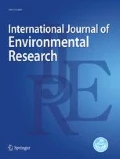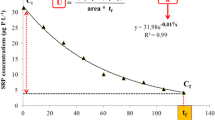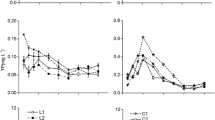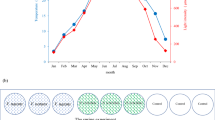Abstract
The objective of this study was to analyze the influence of periphyton biofilm on nutrient releases from sediments in ponds and lakes. The physico-chemical parameters in the overlying water, the TP content, and the P forms in the sediments and periphyton biofilm were measured. The results showed that (1) periphyton biofilm could change the physico-chemical indexes in the overlying water; furthermore, the periphyton biofilm influenced the release of N and P from sediments, and its extent of influence was closely related to the nutrient levels of the sediments. (2) The periphyton biofilms effectively reduced the concentrations of N and P in sediments with different nutritional levels (P < 0.05). The average daily TN removal rates were 52% and 25% in the pond and lake microcosms, respectively, and the average daily TP removal rates were 1.06% and 20.9% in the pond and lake microcosms, respectively. This result suggested that periphyton biofilms acted as biological buffers for nutrient cycling between sediments and overlying water; these buffering effects were mainly through the absorption, filtration, and precipitation of nutrients. (3) The TP content and P forms of the periphyton biofilm were different between the pond and lake microcosms, which indicated that the P forms of the periphyton biofilm were potentially influenced by the nutritional levels of the sediments.
Article Highlights
-
There are different in the influence of periphyton biofilm on nutrient releases from sediments in ponds and lakes.
-
Periphyton biofilm could change the physico-chemical indexes in the overlying water; furthermore, the periphyton biofilm influenced the release of N and P from sediments, and its extent of influence was closely related to the nutrient levels of the sediments.
-
The TP content and P forms of the periphyton biofilm were different between the pond and lake microcosms.




Similar content being viewed by others
References
Ajayan A, Kumar A (2016) On the seasonal changes in the surface water chemistry of Museum Lake, Thiruvananthapuram, Kerala, India. Pollution 2(2):103–114
APHA (2002) Standard methods for the evaluation of water and wastewater, 22nd edn. American Public Health Association, Washington, DC
Cao J, Hong X, Pei G (2014) Removal and retention of phosphorus by periphyton from wastewater with high organic load. Water Sci Technol J Int Assoc Water Pollut Res 70(1):62–69
Christophoridis C, Fytianos K (2006) Conditions affecting the release of phosphorus from surface lake sediments. J Environ Qual 35(4):1181–1192
Das Sharma S (2019) Risk assessment and mitigation measures on the heavy metal polluted water and sediment of the Kolleru Lake in Andhra Pradesh, India. Pollution 5(1):161–178
De-Bashan LE, Bashan Y (2004) Recent advances in removing phosphorus from wastewater and its future use as fertilizer (1997–2003). Water Res 38(19):4222–4246
Dittrich M, Gabriel O, Rutzen C, Koschel R (2011) Lake restoration by hypolimnetic Ca(OH) 2 treatment: impact on phosphorus sedimentation and release from sediment. Sci Total Environ 409(8):1504–1515
Dodds WK (2010) The role of periphyton in phosphorus retention in shallow freshwater aquatic systems. J Phycol 39(5):840–849
Duhamel S, Björkman KM, Wambeke FV, Moutin T, Karl DM (2011) Characterization of alkaline phosphatase activity in the North and South Pacific Subtropical Gyres: implications for phosphorus cycling. Limnol Oceanogr 56(4):1244–1254
Hantke B, Fleischer P, Domany I, Koch M, Pleß P, Wiendl M, Melzer A (1996) P-release from DOP by phosphatase activity in comparison to P excretion by zooplankton. Studies in hardwater lakes of different trophic level. Hydrobiologia 317(2):151–162
House WA, Denison FH, Armitage PD (1995) Comparison of the uptake of inorganic phosphorus to a suspended and stream bed-sediment. Water Res 29(3):767–779
Kaiserli A, Voutsa D, Samara C (2002) Phosphorus fractionation in lake sediments–lakes Volvi and Koronia, N. Greece. Chemosphere 46(8):1147–1155
Lu H, Yang L, Zhang S, Wu Y (2014) The behavior of organic phosphorus under non-point source wastewater in the presence of phototrophic periphyton. PLoS ONE 9(1):e85910
Lu H, Wan J, Li J, Shao H, Wu Y (2016) Periphytic biofilm: a buffer for phosphorus precipitation and release between sediments and water. Chemosphere 144:2058–2064
Mccormick PV, Iii RBES, Chimney MJ (2006) Periphyton as a potential phosphorus sink in the Everglades Nutrient Removal Project. Ecol Eng 27(4):279–289
Michener WK (2018) Quality assurance and quality control (QA/QC)
Najar I, Khan A, Hai A (2017) Evaluation of seasonal variability in surface water quality of Shallow Valley Lake, Kashmir, India, using multivariate statistical techniques. Pollution 3(3):349–362
Ruban V, Lópezsánchez JF, Pardo P, Rauret G, Muntau H, Quevauviller P (2001) Harmonized protocol and certified reference material for the determination of extractable contents of phosphorus in freshwater sediments–a synthesis of recent works. Fresenius J Anal Chem 370(2–3):224–228
Rydin E, Brunberg AK (1998) Seasonal dynamics of phosphorus in Lake Erken surface sediments. Archhydrobioll Specissues Advanclimno 51:157–167
Solórzano L, Sharp JH (1980) Determination of total dissolved phosphorus and particulate phosphorus in natural waters. Limnol Oceanogr 25(4):754–758
Wang S, Jin X, Zhao H, Wu F (2006) Phosphorus fractions and its release in the sediments from the shallow lakes in the middle and lower reaches of Yangtze River area in China. Colloids Surf A 273(1–3):109–116
Wang S, Jin X, Bu Q, Jiao L, Wu F (2008) Effects of dissolved oxygen supply level on phosphorus release from lake sediments. Colloids Surf A 316(1):245–252
Wang H, Holden J, Spera K, Xu X, Wang Z, Luan J, Xu X, Zhang Z (2013) Phosphorus fluxes at the sediment-water interface in subtropical wetlands subjected to experimental warming: a microcosm study. Chemosphere 90(6):1794–1804
Wu Y (2016) Periphyton: functions and application in environmental remediation. Elsevier, Amsterdam
Wu Y, Zhang S, Zhao H, Yang L (2010) Environmentally benign periphyton bioreactors for controlling cyanobacterial growth. Biores Technol 101(24):9681–9687
Wu Y, Li T, Yang L (2012) Mechanisms of removing pollutants from aqueous solutions by microorganisms and their aggregates: a review. Biores Technol 107(2):10–18
Wu Y, Xia L, Yu Z, Shabbir S, Kerr PG (2014) In situ bioremediation of surface waters by periphytons. Biores Technol 151(1):367–372
Wu Y, Liu J, Rene ER (2017) Periphytic biofilms: a promising nutrient utilization regulator in wetlands. Biores Technol 248(Pt B):44–48
Xie LQ, Xie P, Tang HJ (2003) Enhancement of dissolved phosphorus release from sediment to lake water by Microcystis blooms—an enclosure experiment in a hyper-eutrophic, subtropical Chinese lake. Environ Pollut 122(3):391–399
Yang L, Lei K, Yan W, Li Y (2013) Internal loads of nutrients in Lake Chaohu of China: implications for lake eutrophication. Int J Environ Res 7(4):1021–1028
Zhang XF, Mei XY (2015) Effects of benthic algae on release of soluble reactive phosphorus from sediments: a radioisotope tracing study. Water Sci Eng 8(2):127–131
Zhang X, Liu Z, Jeppesen E (2013) The effect of benthic algae on phosphorus exchange between sediment and; overlying water in shallow lakes: a microcosm study using P-32 as a tracer. Hydrobiologia 710(1):109–116
Zhang Y, He F, Xia S, Zhou Q, Wu Z (2015) Studies on the treatment efficiency of sediment phosphorus with a combined technology of PCFM and submerged macrophytes. Environ Pollut 206:705–711
Zhou Q, Gibson CE, Zhu Y (2001) Evaluation of phosphorus bioavailability in sediments of three contrasting lakes in China and the UK. Chemosphere 42(2):221–225
Acknowledgements
This research was supported by the National Science Foundation of China (grant number 30970550), “the Fundamental Research Funds for the Central Universities”, the South-central University for Nationalities (Grant Number czy18019) ,and the Major Technological Innovation of Hubei Province of China (Grant No.2018ABA093).
Author information
Authors and Affiliations
Corresponding author
Ethics declarations
Conflict of interest
The authors have declared no conflict of interest.
Rights and permissions
About this article
Cite this article
Yi, Z., Yang, Y., Yan, C. et al. The Influence of Periphyton Biofilm on Phosphorus Migration in Sediments. Int J Environ Res 13, 327–335 (2019). https://doi.org/10.1007/s41742-019-00182-z
Received:
Revised:
Accepted:
Published:
Issue Date:
DOI: https://doi.org/10.1007/s41742-019-00182-z




